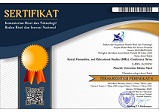History and Types of Education in Indonesia and Its Impact on Economic Growth
Abstract
The Nawacita program framework, the Government of Indonesia is trying to improve the quality and equity of the national education system by increasing the education sector national budget to 500 trillion rupiah, and appointing the Chief Executive Officers (CEO) of the Gojek Internet Start-up company, in order to boost up the program outcome by using Information Technology (IT) as the main gap bridge in the education sectors. The unequal access to the education level in the formal, informal and non-formal education clusters is emphasizes if the education sectors problems is complex as the development problem. The government trying to tackling that problem by developing the suitable curriculum, and maximization of the use of IT in the education sectors to improve the quality and equity for the education. In this research, the correlation between the rapid development of education sectors and the impact to the national economy is analyzed by using the Solow models which said if the investment of human capital, including to the education sectors is one of the main bridge to achieve the status as advanced nation. This research is concluded if the formal education sector have direct and significant impact to the economic sector, then the informal and non-formal educations sectors act as supporting unit in order to achieve the quality and equity, in order to improve the education access.
Keywords
Full Text:
PDFRefbacks
- There are currently no refbacks.





